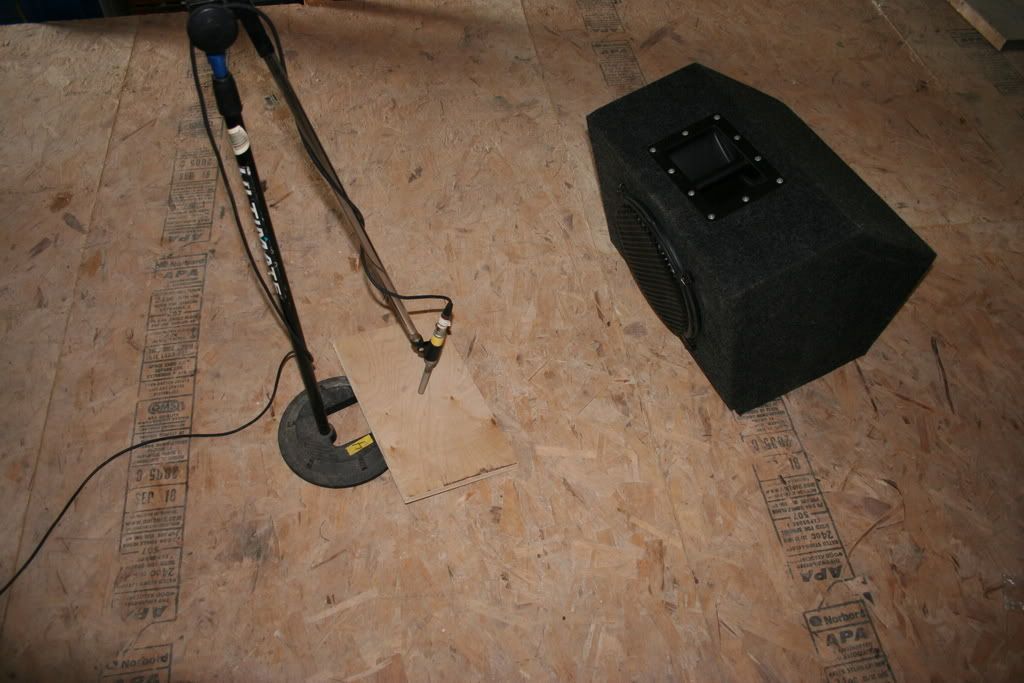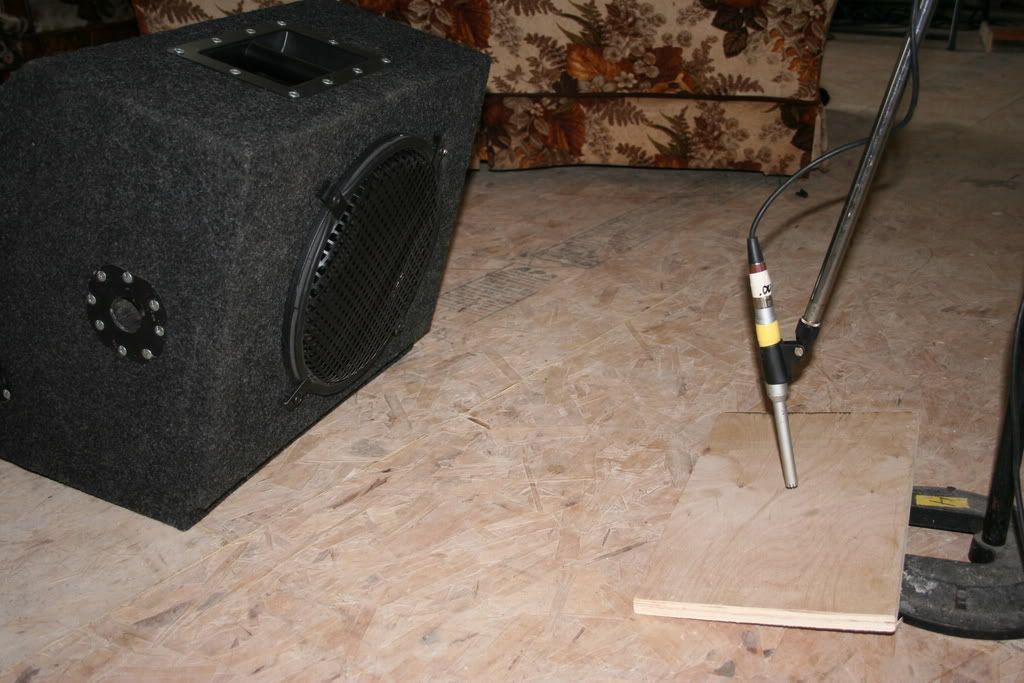Options
Indoor Auto EQ method
This method has a couple of nice benefits... one, close mic'ed like this the process isn't / doesn't have to be very loud, and even a \"high Precision\" setting doesn't take very long... usually less than 30 seconds! (the DRPA + takes about 5 seconds or less) The DRPA has a window of what it expects to hear for the process and won't let you be too loud or too soft, so just go with what the DRPA sets as volume. If you don't the Auto EQ won't run. Try and get the mic about 1/8-1/4 inch away from the floor. (or lying on it's side on a carpet or towel if you don't have a mic stand available)
I did this with my new 12\" coaxial tops, (as you can see in the pictures) and I was able to store High precision setups for -0-, A, C, and D, precurves in about 10 minutes, and that includes a couple passes @ -0- (flat) to get as flat a response as possible using the PEQ's with no \"GEQ\" equalization. (note: with the DRPA PA+ and PX, I have since started using the PEQ's for room adjustments and stopped trying to use them to take the major adjustments out of the GEQ... there just isn't enough of them and I feel it's better to have for broad room adjustments that the GEQ isn't good for.
If you are wondering, this is very much like a PZM setup, and if I had a short mic stand at the time I would not have needed the small board, I would just have gotten the mic head closer to the floor and the base of the mic stand would be away from the mic's tip, that would have been the preferred method. Also a towel around the stand would have been a good idea to block reflections off the stand..ya, it's THAT fussy...)
Its important to tip the speakers down, and get the mic into a spot that the horn/tweeter in the speaker is in the direct field of the measurement mic.(note how the speaker is tipped forward) We have also discovered thanks to Dennis, that if the speaker is laid on it's side, and use a ground plane measuring technique, that we can do even really tall dual woofer speakers and not have a dangerous tilt to them.
The area I used was ~ 20 square feet, with various objects @ the perimeter...concrete floor.(edge of the garage/ shop complex) I suggest blankets or soft towels to cover any hard reflective surfaces that are near the speakers sound path.
Oh and that brings up another thought... I stored the presets @ fullrange, and then used the xover to set the point the subs take over and adjusted the EQ below 150hz by ear, as opposed to doing the subs and tops together. I feel this gave me a more linear response @ the crossover point, and I can then use the speakers full range, or bi-amp using the same stored flat/precurve setups. If your setting up monitors, do a fullrange setup and then use a suitable hipass for them I seem to find 120-150 hz works well.
Note: If you can do the outdoor method that is a better way...but if not try this It works well.
In later testing Dennis has indicated that by following the bottom picture, with the box on it's side, (except for foldback monitor use) the results are more usable...
Be well, and Good mixing.
Gadget

 [/img]
[/img]

I did this with my new 12\" coaxial tops, (as you can see in the pictures) and I was able to store High precision setups for -0-, A, C, and D, precurves in about 10 minutes, and that includes a couple passes @ -0- (flat) to get as flat a response as possible using the PEQ's with no \"GEQ\" equalization. (note: with the DRPA PA+ and PX, I have since started using the PEQ's for room adjustments and stopped trying to use them to take the major adjustments out of the GEQ... there just isn't enough of them and I feel it's better to have for broad room adjustments that the GEQ isn't good for.
If you are wondering, this is very much like a PZM setup, and if I had a short mic stand at the time I would not have needed the small board, I would just have gotten the mic head closer to the floor and the base of the mic stand would be away from the mic's tip, that would have been the preferred method. Also a towel around the stand would have been a good idea to block reflections off the stand..ya, it's THAT fussy...)
Its important to tip the speakers down, and get the mic into a spot that the horn/tweeter in the speaker is in the direct field of the measurement mic.(note how the speaker is tipped forward) We have also discovered thanks to Dennis, that if the speaker is laid on it's side, and use a ground plane measuring technique, that we can do even really tall dual woofer speakers and not have a dangerous tilt to them.
The area I used was ~ 20 square feet, with various objects @ the perimeter...concrete floor.(edge of the garage/ shop complex) I suggest blankets or soft towels to cover any hard reflective surfaces that are near the speakers sound path.
Oh and that brings up another thought... I stored the presets @ fullrange, and then used the xover to set the point the subs take over and adjusted the EQ below 150hz by ear, as opposed to doing the subs and tops together. I feel this gave me a more linear response @ the crossover point, and I can then use the speakers full range, or bi-amp using the same stored flat/precurve setups. If your setting up monitors, do a fullrange setup and then use a suitable hipass for them I seem to find 120-150 hz works well.
Note: If you can do the outdoor method that is a better way...but if not try this It works well.
In later testing Dennis has indicated that by following the bottom picture, with the box on it's side, (except for foldback monitor use) the results are more usable...
Be well, and Good mixing.
Gadget

 [/img]
[/img]
0